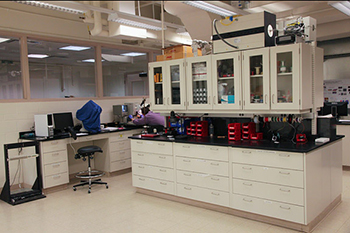Jadwin Hall Leads Princeton’s Energy Plan
 PRINCETON, N.J. — A large-scale, 230,000-square-foot renovation and addition to Jadwin Hall at Princeton University is the first of many buildings to be retrofitted as part of the school’s aggressive global sustainability plan, which focuses on reducing campus emissions to 1990 levels (about 20,000 metric tons less than the current 115,000 metric tons) by 2020.
PRINCETON, N.J. — A large-scale, 230,000-square-foot renovation and addition to Jadwin Hall at Princeton University is the first of many buildings to be retrofitted as part of the school’s aggressive global sustainability plan, which focuses on reducing campus emissions to 1990 levels (about 20,000 metric tons less than the current 115,000 metric tons) by 2020.
Philadelphia-based MGA Partners designed, planned and managed the $30 million phased project, which started in 2009 and is now 95 percent complete, according to The Times of Trenton. Since Jadwin Hall had to remain in operation year round throughout the renovation, the multi-year phasing plan was essential to the project’s success. The project consists of transforming a 1960s-era physics building, originally designed by Hugh Stubbins, into a sustainable building that would serve as a model for future projects.
Home to the university’s physics department for more than 40 years, Jadwin Hall was one of the university’s biggest energy users, Project Manager Cathy Altadonna told The Times of Trenton. A large part of that was because of the extra energy required for scientists to conduct experiments while using fume hoods to keep rooms ventilated where chemicals were being used. Plus, the building was still relying on the same energy plan and heating and ventilation infrastructure that was created for it in the 1960s.
As such, the renovation of Jadwin Hall incorporated a number of sustainable design strategies, which together are projected to achieve a 45 percent reduction in energy consumption. It was designed to maximize the energy efficiency and interior environmental quality of the building, while minimizing disruptions to the ongoing teaching and research activities of the Physics Department.
The new 8,000-square-foot mechanical penthouse, one of the renovation’s key elements, serves the building’s laboratory wing. This addition houses customized air handling equipment with full energy recovery wheels and a dedicated unit with dehumidification that serves the building’s new active chilled-beam system. The construction of the penthouse freed up valuable laboratory space in the basement level. MGA worked with a team of engineers and acousticians to successfully diminish sound and vibration from the new rooftop equipment so as not to impact the sensitive experimentation in the laboratories below.
The outdated heating, ventilation and air-conditioning (HVAC) systems throughout the building were replaced with an efficient variable-air-volume (VAV) and active chilled-beam system that incorporates occupancy and demand-controlled ventilation, as well as radiant heating panels around the building’s perimeter. To complement the HVAC improvements, inefficient single-pane window units were replaced with a high-performance, thermally broken window wall system, and closed-cell foam insulation was installed to provide a tighter building envelope.
Other sustainable measures, such as soy-based insulation, plant-based linoleum tiles and daylight-harvesting light sensors — which sense the amount of daylight in a room and dim the lights accordingly — were also factors in the upgrade, Altadonna told The Times of Trenton.
Now, the facility primarily serves as an administration building. MGA created several new lounge spaces with glass walls to pull daylight deeper into the building and encourage interaction and collaboration among faculty.
